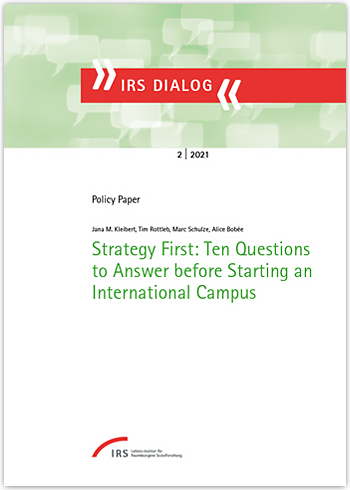Main Content
Strategy First: Ten Questions to Answer before Starting an International Campus
IRS Dialog 2 | 2021

“There are some horror stories out there that we kind of pick up on […] There are many universities who have gone on very, very ambitious schemes and establishing big campuses very expensively. And we feel from the intelligence we pick up, that quite a few of them do not make any money. And quite a few of them have actually cost the universities significant sums of money […] So, I guess it depends on the risk appetite of different universities, and also, I think sometimes the naivety of universities as they approach different markets. You know? They naturally seem that it is all going to go fantastically well, they put down millions into those markets and then perhaps realize it is not going quite so well as they hoped”
(Interview Pro-Vice Chancellor, UK)
Our data show a paradox: offshore campuses, defined as transnational education involving physical presences of universities that deliver international degrees in another country, have grown strongly and amount to almost 500 campuses globally (Kleibert et al., 2020a). Simultaneously, we see how offshore campuses have closed every year over the past 15 years. Several cases of failed investments have been prominently covered in the news, for instance University of New South Wales pulled out of Singapore just four months after its opening.
The reasons for campus closures are diverse; some may have been set up with a limited time frame of existence planned from the start. Moreover, our research shows that many offshore campus projects were planned but were cancelled prior to starting their operations. These ‘ghost’ campuses, proudly announced in newspaper reports on the web but never materialised, will have cost the universities significant sums of time and money at the planning stage, while ultimately failing to take off. These closures and cancelled projects may only be the visible top of an iceberg in the water, with many more campuses experiencing fundamental problems in their day-to-day operations and challenges to realise their ambitions. The difficulties inherent in offshore campus development as a particular form of internationalisation of higher education are manifold. The academic community acknowledges the risks of offshore campus development, which often involves sizeable investments of time and financial resources in non-core activities. Higher education scholars have argued that international branch campus development is a “high-risk growth strategy and unsuccessful ventures can result in huge financial losses and reputational consequences” (Wilkins and Huismans, 2012: 628; see also Altbach, 2015).
Based on our discussions with 136 senior higher education managers and transnational education stakeholders in Europe, Southeast Asia and the Middle East held between 2018 and 2020, we analyse the six most important risks for offshore campuses. These include a lack of institutional strategy, financial and reputational risks as well as risks relating to peripheral locations, risky partnerships, and changing regulations in host environments. By learning from cases around the world, we hope to develop ideas on how to assess and mitigate risks and develop more sustainable campuses in the future. We conclude with a checklist of ten questions to ask prior to starting a branch campus.

